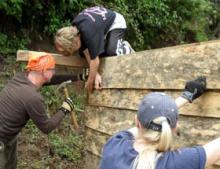
Photo by flattop341
You may have never tried project-based learning, or you may teach in a purely PBL environment. Whatever your background, you’ll find that PBL can be a powerful instructional approach. Here are ten reasons why.
- Adult life is project based. Most tasks that adults complete are projects, from simple duties like doing laundry and baking cookies to major endeavors like finding a job or renovating a home. Adults rarely listen to lectures, take notes, and pass tests. Instead, they take on projects. Project-based learning helps students learn content while they practice the skills they need as adults. For a great explanation of this connection, watch this video from the Buck Institute for Education.
- Projects prepare students for future work. Any project that can be done the same way over and over with consistent results will soon be outsourced, automated, or digitized. Any project that requires nonlinear thinking, decision making, and problem solving requires a human being. It’s a job—the best kind of job for the future. Watch Thomas Friedman's remarks to the U.S. Conference of Mayors, in which he covers these points from minutes 18:00-34:10.
- Projects teach content and 21st century skills. The only way students can learn to collaborate is to collaborate on something. Yes, collaboration can be messy, but that’s all the more reason students need to learn to deal with the messiness. Projects require students to develop the 21st century skills that they need, such as thinking critically and creatively, communicating and collaborating, and consuming and producing information.
- Projects have built-in goals. When you start a real-world project, you think about the outcome you want. If you want to fix the kitchen sink so that it no longer leaks, you know whether you succeed or fail based on that goal. If you want to remodel your kitchen to double the counter space, add more cabinets, and have a larger refrigerator, you won’t be satisfied with a result that does not meet these goals. On the other hand, if your remodeled kitchen has all of these features and many more, you will be thrilled. All projects have built-in goals, and students grasp them easily.
- Students turn goals into rubrics. When a skateboarder wants to grind down a handrail, he knows right away whether his stunt was a “win” or a “fail.” When students set authentic goals for themselves, they tend to set them high. They want a total “win.” From a very early age, students can identify their goals and write them in a rubric. Skeptical? Check out the bridge challenge from intrepid inquiry teachers Amy Dawn Park and Deirdre Bailey. (Follow them on Twitter @amydawnpark and @deirdrebailey.) They routinely have 3rd and 4th graders create challenging rubrics.
- Projects are standards based. Of course, the students aren’t the only ones who get a say in the rubric. The teacher also provides specific standards. And the initial parameters of the project make sure that students learn core content. For brilliant examples of how this process works, check out the classroom blog of Bailey and Park.
- Projects require students to be active. Instead of passively receiving knowledge from their teachers, students have to actively seek knowledge. Instead of expecting the teacher to be the “sage on the stage,” students expect the teacher to be the “guide on the side.” The teacher doesn’t have to have all the answers, and students are responsible for their own success. Project-based learning requires the teacher to step back and the student to step forward.
- Project-based learning requires student engagement. A disengaged student cannot learn; engaged students can’t help learning. Disengaged students direct their energies into disruptive behavior and require constant management. Engaged students direct their energies into constructive behavior and require occasional redirection. By requiring students to develop their own work, project-based learning facilitates engagement.
- Project-based learning is scaleable. Just as grocery shopping is a small project and a Mars mission is a huge one, classroom projects can range from half-hour inquiries to multi-year, multi-class endeavors. You can choose whatever size works for you. You can also start slow, incorporating one small project every month, and then increase to larger and larger projects. You may eventually want to shift to an entirely project-based approach.
- Project-based learning is fun. The word “fun” is too often seen as the opposite of “rigorous.” The thought is that classes need to be hard and unfun in order to be rigorous. But there are many hard, unfun things that have nothing to do with learning. Getting a root canal, for example, or getting audited by the IRS are rigorous without a bit of learning. How about putting on a play? That’s rigorous fun that involves plenty of critical and creative thinking, plenty of communication and collaboration. Project-based learning can turn any classroom into a stage for students instead of a room full of anesthetized kids waiting for the inevitable drill.